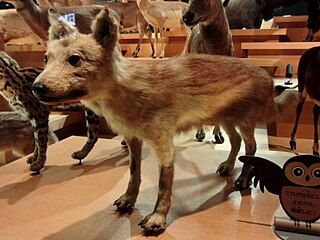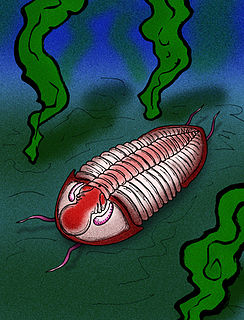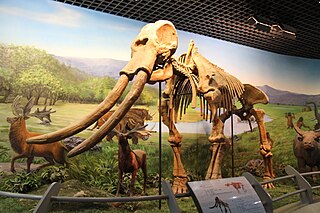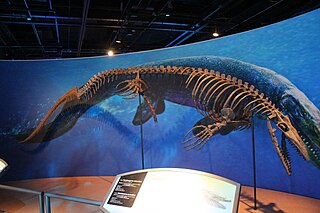 W
WAinoceras is a genus of extinct, aberrantly coiled ammonite cephalopod that live in the Pacific Ocean during the Campanian division of the Cretaceous, where Japan is today. Their shells were coiled very similarly to the related Anaklinoceras, in that, when young, the shell coiled helically, and then upon reaching adulthood, the shell then bent over the older coils. However, Ainoceras differed in this respect in that, whereas in Anaklinoceras, the youngest coil wrapped very closely around the older coils, while in Ainoceras, the youngest coil bent over the older coils in a wide loop or oxbow.
 W
WAllodesmus is an extinct genus of pinniped from the middle to late Miocene of California and Japan that belongs to the extinct pinniped family Desmatophocidae.
 W
WArgonauticeras is an extinct ammonoid cephalopod genus that lived during the latter part of the Early Cretaceous, included in the Lytoceratida and found in lower and possibly middle Aptian marine sediments. It has been thought of as a subgenus of Ammonoceratites.
 W
WThe Bonin grosbeak or Bonin Islands grosbeak is an extinct finch. It is one of the diverse bird taxa that are vernacularly called "grosbeaks", but it is not closely related to the grosbeaks sensu stricto. Many authorities place the species in the genus Carpodacus, but some place it in its own genus, Chaunoproctus. A 2013 genetic analysis found it to be a relatively basal member of the group, more derived than the common rosefinch, but with no close relatives, with an estimated divergence time from other members of the group around 12.5 million years ago.
 W
WThe Bonin nankeen night heron is an extinct subspecies of the nankeen night heron.
 W
WThe Bonin wood pigeon was a pigeon endemic to Nakodo-jima and Chichi-jima in the Ogasawara Islands, south of Japan. It is known from four recorded specimens, the first from 1827 and the last from 1889. They averaged a length of 45 cm. This pigeon died out late in the 19th century as a result of deforestation, hunting, and predation by introduced rats and cats.
 W
WBrygmophyseter, known as the biting sperm whale, is an extinct genus of toothed whale in the sperm whale family with one species, B. shigensis. When it was first described in 1994, the species was placed in the genus Scaldicetus based on tooth morphology, but this was later revised in 1995. In 2006, it was classified into the genus Naganocetus, which is considered to be a junior synonym. The only known specimen, a nearly complete skeleton, was dated to be around 14–15 million years old. Brygmophyseter is thought to have been 7 meters (23 ft) long, and it probably had 11 or 12 teeth in the upper and lower jaws. Brygmophyseter is part of a group of macroraptorial sperm whales which tended to be apex predators using their large teeth to catch struggling prey such as whales. It had a spermaceti organ which was probably used for biosonar like in the modern sperm whale. The whale has made an appearance on The History Channel's TV series Jurassic Fight Club.
 W
WClidoderma is a genus of righteye flounders containing one extant species and two described fossil species from Japan.
 W
WDesmostylus is an extinct genus of herbivorous mammal of the family Desmostylidae living from the Chattian stage of the Late Oligocene subepoch through the Late Miocene subepoch and in existence for approximately 21.2 million years .
 W
WDiatomys is an extinct rodent genus known from Miocene deposits in China, Japan, Pakistan, and Thailand. The fossil range is from the late Early Miocene to the Middle Miocene.
 W
WEndops yanagisawai is a proetid trilobite belonging to the family Proetidae, endemic to Middle Permian-aged marine strata in Fukushima Prefecture, Japan. It was originally described by Riuji Endo as Paladin yanagisawai.
 W
WFukuiraptor was a medium-sized megaraptoran theropod dinosaur of the Early Cretaceous epoch that lived in what is now Japan.
 W
WFukuititan is a genus of titanosauriform sauropod dinosaur that lived in the Early Cretaceous in what is now Japan. It is known from FPDM-V8468, the associated partial skeleton of a single individual, recovered from the Kitadani Dinosaur Quarry of the Tetori Group, at Katsuyama City. The type species, Fukuititan nipponensis, was described in 2010 by Japanese scientists Yoichi Azuma and Masateru Shibata of the Fukui Prefectural Dinosaur Museum. The discovery sheds light on Japanese titanosauriforms, which are poorly known in the region.
 W
WFukuivenator is an extinct genus of coelurosaurian theropod dinosaur from the Early Cretaceous of Japan.
 W
WFutabasaurus is a genus of plesiosaur from the Late Cretaceous of Fukushima, Japan. It was described and named in 2006, and was assigned to the family Elasmosauridae. The genus contains one species, F. suzukii.
 W
WThe Hokkaido wolf, also known as the Ezo wolf and in Russia as the Sakhalin wolf, is an extinct subspecies of gray wolf that once inhabited coastal north-east Asia. Its nearest relatives were the wolves of North America rather than Asia. It was exterminated in Hokkaidō during the Meiji Restoration period, when American-style agricultural reforms incorporated the use of strychnine-laced baits to kill livestock predators. Some taxonomists believe that it survived up until 1945 on Sakhalin island. It was one of two subspecies that were once found in the Japanese archipelago, the other being the Japanese wolf.
 W
WThe Japanese river otter (Japanese: ニホンカワウソ is an extinct variety of otter formerly widespread in Japan. Dating back to the 1880s, it was even seen in Tokyo. The population suddenly shrank in the 1930s, and the mammal nearly vanished. Since then, it has only been spotted several times, in 1964 in the Seto Inland Sea, and in the Uwa Sea in 1972 and 1973. The last official sighting was in the southern part of Kōchi Prefecture in 1979, when it was photographed in the mouth of the Shinjo River in Susaki. It was subsequently classified as a "Critically Endangered" species on the Japanese Red List. On August 28, 2012, the Japanese river otter was officially declared extinct by the Ministry of the Environment. It is the official animal symbol of Ehime Prefecture. In February 2017, a wild otter was caught on camera on Tsushima Island, Nagasaki Prefecture. However, it is not known whether the observed otter was a Japanese river otter.
 W
WThe Japanese sea lion was an aquatic mammal thought to have become extinct in the 1970s. It was considered to be a subspecies of California sea lion until 2003. They inhabited the Sea of Japan, especially around the coastal areas of the Japanese Archipelago and the Korean Peninsula. They generally bred on sandy beaches which were open and flat, but sometimes in rocky areas. They were hunted commercially in the 1900s, leading to their extinction.
 W
WThe Japanese wolf (Japanese: ニホンオオカミ is an extinct subspecies of the gray wolf that was once endemic to the islands of Honshū, Shikoku and Kyūshū in the Japanese archipelago. It is also known as the Honshū wolf. Its binomial name derives from the Greek Hodos and phylax, in reference to Japanese folklore, which portrayed wolves as the protectors of travellers. It was one of two subspecies that were once found in the Japanese archipelago, the other being the Hokkaido wolf.
 W
WKaganaias is an extinct genus of mosasauroid lizard that lived in what is now Japan during the Early Cretaceous. Kaganaias was semi-aquatic and is the only known aquatic squamate to be found in Asia and is also the only known aquatic squamate known from before the Cenomanian stage of the Cretaceous. It is also the first to be found in an inland area, instead of on the coast where aquatic squamates are commonly found. Its generic name is derived from Kaga Province, the old name for the Ishikawa Prefecture where the specimens were found, while the species name hakusanensis comes from the mountain that gives its name to Hakusan the city near its find site. The geological formation in which the specimens were found, the Kuwajima Formation, stands alongside the Tetori River and has been the site of numerous other finds including molluscs, dinosaurs, fish and pterosaurs.
 W
WKoshisaurus is a monospecific genus of basal hadrosauroid from the Kitadani Formation in Japan. The discovery of the genus suggests that hadrosauroids had higher diversity along the eastern margin of Asia in the Early Cretaceous. "Koshi" means an old Japanese regional name including Fukui prefecture where fossils of the genus were discovered.
 W
WMesodermochelys is an extinct genus of sea turtle known from the Campanian to the Maastrichtian of what today is Japan. One species is known, the type species M. undulatus; it was given its binomial name by Ren Hirayama and Tsutomu Chitoku in 1996. Studies of its skull indicate that it was a primitive member of the Dermochelyidae that was closely related to the Protostegidae. It has been described as the best representative of Mesozoic dermochelyids.
 W
WThe Mukojima white-eye, incorrectly known as the Mukojima honeyeater, is the extinct nominate subspecies of the Bonin white-eye. It occurred on Muko-jima and Nakodo-jima in the northern group of the Ogasawara Islands. The last record were specimens taken in January 1930 on Muko-jima; by then, the bird was already gone from Nakodo-jima. In 1941, the subspecies was found to have gone extinct in the meantime.
 W
WNipponaspis is a genus of proetid trilobite belonging to the family Phillipsiidae. Fossils of the various species are found in Middle Permian-aged marine strata of Fukushima Prefecture, Japan, China, Korea, and Alaska.
 W
WPalaeoloxodon naumanni, occasionally called Naumann's elephant, is an extinct species belonging to the genus Palaeoloxodon that was endemic to the Japanese archipelago during the Middle to Late Pleistocene around 430,000 to 24,000 years ago. It is named after Heinrich Edmund Naumann who discovered the first fossils at Yokosuka, Kanagawa, Japan.
 W
WPaleoparadoxia is a genus of large, herbivorous aquatic mammals that inhabited the northern Pacific coastal region during the Miocene epoch. It ranged from the waters of Japan, to Alaska in the north, and down to Baja California, Mexico. Paleoparadoxia was about 2.2 m long.
 W
WPhosphorosaurus is an extinct genus of marine lizard belonging to the mosasaur family. Phosphorosaurus is classified within the Halisaurinae subfamily alongside the genera Pluridens, Eonatator and Halisaurus.
 W
WShokawa ikoi was a 1.8 m long choristoderan diapsid reptile closely resembling and closely related to the smaller choristoderan, Hyphalosaurus. It lived during the Lower Cretaceous in what is now Japan.
 W
WTambatitanis is an extinct genus of titanosauriform dinosaur from the Early Cretaceous of Japan. It is known from a single type species, Tambatitanis amicitiae, which is known from the Sasayama Group. It was probably around 14 meters long and its mass was estimated at some 4 tonnes. It was a basal titanosauriform and possibly belonged to the Euhelopodidae. The holotype was collected between 2006-2010.
 W
WTaniwhasaurus is an extinct genus of mosasaur which inhabited New Zealand, Japan and Antarctica. The genus was a close relative of the genus Tylosaurus.
 W
WToyotamaphimeia machikanensis is an extinct tomistomine crocodylian which lived in Japan during the Pleistocene. A specimen recovered in 1964 at Osaka University during the construction of a new science building has been dated to around 430–380 thousand years old based on the stratum in which it was found. T. machikanensis was a fairly large crocodylian with a 1 m (3.3 ft) skull and a total length up to 8 m (26 ft). It is closely related to the false gharial and was originally described as a member of the same genus, Tomistoma.